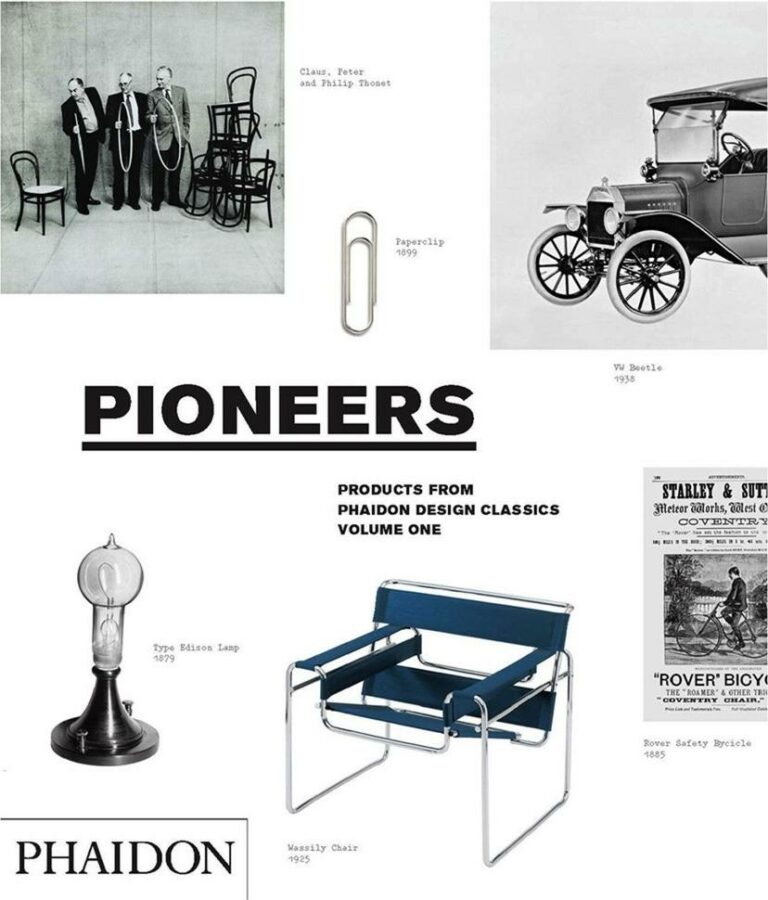Pioneers (Products From Phaidon Design Classics, Vol. 1)

A ‘design classic’ is an industrially manufactured object with timeless aesthetic value. It serves as a standard of its kind and, despite the year in which it was designed, is still up to date. The collection presented in these three volumes has been put together by a group of experts following the above criteria. The objects are presented chronologically, beginning with an elegant pair of Chinese bonsai scissors from the early 1800s, still in production today, and ending with Jasper Morrison’s recent ‘brunch set’, which is destined to become a ‘classic’. Glancing through the volumes, the reader will gain an understanding not only of the history of design, but a history of taste and culture. The book is an extraordinary journey through the objects that have shaped our society, from the first attempts to combine function and beauty in the nineteenth century, through the machine aesthetics of the thirties, the advent of plastic and other new materials in the fifties and sixties, up to the ‘classics’-to-be of the last ten years. The book includes not only classic objects created by great and internationally renowned designers, such as Breuer, Le Corbusier, Dreyfuss, Eames, Yanagi and Castiglioni, to name but a few, but also anonymously designed pieces, such as the clothes peg, the deck chair, the corkscrew and the chopstick, which, in spite of lacking a specific designer, have achieved such perfection in design and functionality that they have eliminated the possibility of improvement. From the paper clip, to the Alvar Aalto Savoy vase, to the Jaguar E Type, all of the objects featured in the book fill our desks, cupboards, kitchens, purses, dreams and pockets. A ‘design classic’ is an industrially manufactured object with timeless aesthetic value. It serves as a standard of its kind and, despite the year in which it was designed, is still up to date. The collection presented in these three volumes has been put together by a group of experts following the above criteria. The objects are presented chronologically, beginning with an elegant pair of Chinese bonsai scissors from the early 1800s, still in production today, and ending with Jasper Morrison’s recent ‘brunch set’, which is destined to become a ‘classic’. Glancing through the volumes, the reader will gain an understanding not only of the history of design, but a history of taste and culture. The book is an extraordinary journey through the objects that have shaped our society, from the first attempts to combine function and beauty in the nineteenth century, through the machine aesthetics of the thirties, the advent of plastic and other new materials in the fifties and sixties, up to the ‘classics’-to-be of the last ten years. The book includes not only classic objects created by great and internationally renowned designers, such as Breuer, Le Corbusier, Dreyfuss, Eames, Yanagi and Castiglioni, to name but a few, but also anonymously designed pieces, such as the clothes peg, the deck chair, the corkscrew and the chopstick, which, in spite of lacking a specific designer, have achieved such perfection in design and functionality that they have eliminated the possibility of improvement. From the paper clip, to the Alvar Aalto Savoy vase, to the Jaguar E Type, all of the objects featured in the book fill our desks, cupboards, kitchens, purses, dreams and pockets. Each product is presented on two, four or six pages and accompanied by a text, written by one of over fifty experts in the field of design. The texts provide a historical context, with key information about the development of the design, and an explanation as to why that particular design is important and ground-breaking. The texts also uncover curious anecdotes about the design, and the process involved in creating it. In many cases the products are described with details that have not been published before, informing the reader about materials and process, in addition to providing rich insights into each designer’s oeuvre. The contributors have each been invited to write in accordance with their area of speciality and passion. Not only writers, but designers, retailers, critics, curators, architects, historians, and professors, each of international renown, combine to bring a unique perspective on design that is highly detailed and refreshing. Through the informative texts and dazzling quantity of images including sketches, patent drawings, posters, comics and so on, we learn that the safety pin was patented in 1849 and that the famous Thonet chair N. 14, designed in 1859, never went out of production. We realize how clever the zip fastener is and how beautiful the Concorde. While this collection will be ground-breaking in terms of its range of products and periods, it is also the first of its kind with regards to presenting accurate information. With Alan Fletcher’s beautiful design, this is a unique collection that unites factual information with rarely seen images. “999 Design Classics” is a honed and laboriously-selected list of products, most of which are still in production. The objects contained within truly encapsulate what design is and what design will be for decades to come. The following categories of products are featured in the book: Aeroplanes, Ashtrays, Bottle Openers, Bath accessories, Benches, Bicycles, Bins, Boats, Bottles, Bowls, Boxes, Briefcases, Buses, Cabs, Cars, Calculators, Calendars, Cameras, Candle-holders, Caravan, Chairs (armchairs, folding chair, lounge chairs, office chairs, sofas, stools), Clocks, Clothes Stands, Cocktail Shakers, Computers, Containers, Crayons, Cruets, Desks, Door Handles, Drill Bits, Egg Cups, Fans, Flasks, Flatware, Games, and Glassware. This also features: Gliders, Helicopters, Ice Buckets, Knives, Letter Openers, Lighting, Lighters, Lunchboxes, Mailboxes, Motorcycles, Office Systems, Paper-clips, Pens, Pencils, Pencil Sharpeners, Pins, Pitchers, Post-it Notes, Pots & Pans, Radios, Record Players, Rulers, Safety Pins, Salt and Pepper Shakers, Scales, Scissors, Sewing machines, Shavers, Shelves, Sports equipment, Staplers, Storage, Switches, Tables, Table services, Telephones, Televisions, Tools, Torches, Toys, Tractors, Trains, Typewriters, Utensils, Vacuum cleaners, Vases, Walkmans, Watches, Whistles, and Zipper.
Out of stock
Out of stock
